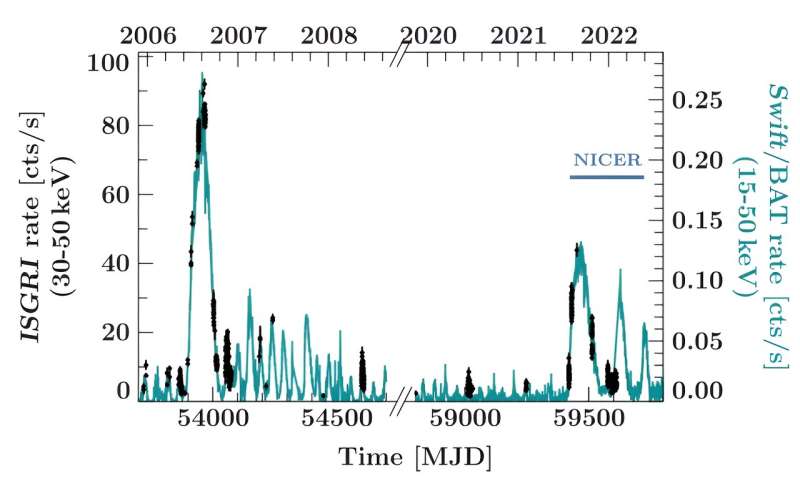June 10, 2024 report
This article has been reviewed according to Science X's editorial process and policies. Editors have highlighted the following attributes while ensuring the content's credibility:
fact-checked
preprint
trusted source
proofread
Astronomers observe giant outburst of a distant X-ray binary

Using the Neutron Star Interior Composition Explorer (NICER) onboard the International Space Station, astronomers have observed a distant X-ray binary known as EXO 2030+375. The observational campaign allowed them to explore a giant outburst that occurred in this system. Results of the observations were published May 31 on the pre-print server arXiv.
X-ray binaries are composed of a normal star or a white dwarf transferring mass onto a compact neutron star or a black hole. Based on the mass of the companion star, astronomers divide them into low-mass X-ray binaries (LMXBs) and high-mass X-ray binaries (HMXBs).
Be/X-ray binaries (Be/XRBs) are the largest subgroup of HMXBs. These systems consist of Be stars and, usually, neutron stars, including pulsars. Observations have found that most of these systems showcase weak persistent X-ray emission that is interrupted by outbursts lasting several weeks.
At a distance of about 7,800 light years away, EXO 2030+375 is a Be/XRB consisting of a magnetized neutron star and a B0 Ve companion. The system has an orbital period of 46 days and the neutron star exhibits X-ray pulsations with a period of approximately 43 seconds.
Since its discovery in 1985, EXO 2030+375 has experienced three giant outbursts—in 1985, 2006, and 2021. The latest outburst, which lasted from June 2021 to early 2022, has been monitored by various instruments, including NICER. Now, a team of astronomers led by Philipp Thalhammer of the University of Erlangen–Nuremberg in Germany, has presented the new results of NICER observations.
"We present the results of both spectral and timing analysis based on NICER monitoring, covering the 2–10 keV flux range from 20 to 310 mCrab. Dense monitoring with observations carried out about every second day and a total exposure time of about 160 ks allowed us to closely track the source evolution over the outburst," the scientists wrote in the paper.
NICER allowed Thalhammer's team to observe two types of transitions in the emission of EXO 2030+375 over the course of the investigated outburst: a transition in the pulse profiles and one in the hardness-luminosity relation. In general, it was found that the profiles show a clear dependence on luminosity with a transition at a luminosity of about 2 undecillion erg/s, suggesting a change in the emission pattern.
The astronomers noted that the detected softening of the spectrum with increasing luminosity fits well with previous outbursts. They added that multiple peaks and dips of the profile have been identified, which can be described simply as a result of a two-component emission pattern originating from two accretion columns.
The study also found that the 2021–2022 outburst reached a significantly lower peak luminosity compared to the previous two outbursts. The authors of the paper assume that this may be due to the earlier onset of the latest outburst than predicted by previous observations.
More information: P. Thalhammer et al, The giant outburst of EXO 2030+375 I: Spectral and pulse profile evolution, arXiv (2024). DOI: 10.48550/arxiv.2405.20734
Journal information: arXiv
© 2024 Science X Network





















